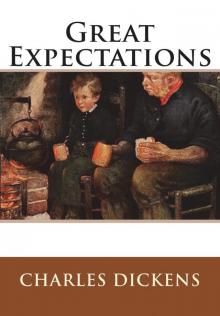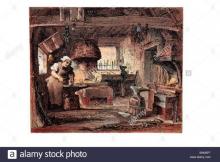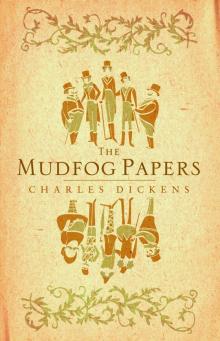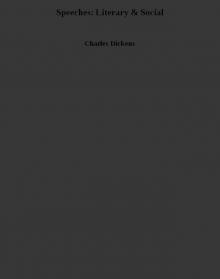- Home
- Charles Dickens
The Mudfog Papers Page 11
The Mudfog Papers Read online
Page 11
p.112, box-lobby: The lobby of a theatre.
p.115, sign manual: Autograph. The term “sign manual” usually refers to the signature of the sovereign.
p.117, Boswell: James Boswell (1740–95), Scottish biographer of the English lexicographer and writer Samuel Johnson (1709–84).
p.117, hack cab: A hackney carriage, the official name for a taxi.
p.120, the Whigs: One of the two political parties in Parliament in the first half of the nineteenth century (the other being the Tories). In this period the Whigs stood for the interests of industrialists, supporting free trade religious dissenters and those seeking constitutional and social reforms.
p.120, there’s a book as belonged to Pope, Byron’s Poems: The point being that this is impossible, since the Augustan poet Alexander Pope (1688–1744) died over forty years before the celebrated Romantic poet George Gordon, Lord Byron (1788–1824) was born.
p.122, d’Orsay: A kind of top hat made with beaver fur fashionable in the early nineteenth century.
p.122, high-lows: Boots worn by military personnel.
p.125, Mysteries of Udolpho: A Gothic novel by Ann Radcliffe (1764–1823), one of the pioneers of the form, published in 1794 and characterized by suspense, sensational incidents of horror and apparently supernatural occurrences.
Extra Material on Charles Dickens’s The Mudfog Papers
Charles Dickens’s Life
Charles John Huffam Dickens was born in Portsmouth on 7th February 1812 to John Dickens and Elizabeth Dickens, née Barrow. His father worked as a navy payroll clerk at the local dockyard, before transferring and moving his family to London in 1814, and then to Kent in 1817. It seems that this period possessed an idyllic atmosphere for ever afterwards in Dickens’s mind. Much of his childhood was spent reading and rereading the books in his father’s library, which included Robinson Crusoe, The Vicar of Wakefield, Don Quixote, Fielding, Smollett and the Arabian Nights. He was a promising, prize-winning pupil at school, and generally distinguished by his cleverness, sensitivity and enthusiasm, although unfortunately this was tempered by his frail and sickly constitution. It was at this time that he also had his first experience of what would become one of the abiding passions in his life: the theatre. Sadly, John Dickens’s finances had become increasingly unhealthy, a situation which was worsened when he was transferred to London in 1822. This relocation, which entailed a termination in his schooling, distressed Charles, though he slowly came to be fascinated with the teeming, squalid streets of London.
In London, however, family finances continued to plummet until the Dickenses were facing bankruptcy. A family connection, James Lamert, offered to employ Charles at the Warren’s Blacking Warehouse, which he was managing, and Dickens started working there in February 1824. He spent between six months and a year there, and the experience would prove to have a profound and lasting effect on him. The work was drudgery – sealing and labelling pots of black paste all day – and his only companions were uneducated working-class boys. His discontent at the situation was compounded by the fact that his talented older sister was sent to the Royal Academy of Music, while he was left in the warehouse.
John Dickens was finally arrested for debt and taken to Marshalsea Prison in Southwark on 20th February 1824, his wife and children (excluding Charles) moving in with him in order to save money. Meanwhile, Charles found lodgings with an intimidating old lady called Mrs Roylance (on whom he apparently modelled Mrs Pipchin in Dombey and Son) in Little College Street, later moving to Lant Street in Borough, which was closer to the prison. At the end of May 1824, John Dickens was released, and gradually paid off creditors as he attempted to start a new life for himself and his family. However, for some time afterwards Charles reluctantly pursued his employment at the blacking factory, as it seems his mother was unwilling to take him out of it, and even tried to arrange for him to return after he did leave. It appears that he was only removed from the warehouse after his father had quarrelled with James Lamert. The stint at the blacking factory was so profoundly humiliating for Dickens that throughout his life he apparently never mentioned this experience to any of those close to him, revealing it only in a fragment of a memoir written in 1848 and presented to his biographer John Forster: “No words can express the secret agony of my soul as I sunk into this companionship, compared these everyday associates with those of my happier childhood, and felt my early hopes of growing up to be a learned and distinguished man crushed in my breast.”
Fortunately he was granted some respite from hard labour when he was sent to be educated at the Wellington House Academy on Hampstead Road. Although the standard of teaching he received was apparently mediocre, the two years he spent at the school were idyllic compared to his warehouse experience, and Charles took advantage of them by making friends his own age and participating in school drama. Regrettably he had to leave the Academy in 1827, when the family finances were in turmoil once again. He found employment as a junior clerk in a solicitor’s office, a job that, although routine and somewhat unfulfilling, enabled Dickens to become familiar with the ways of the London courts and the jargon of the legal profession – which he would later frequently lampoon in his novels. On reaching his eighteenth birthday, Dickens enrolled as a reader at the British Museum, determined to make up for the inadequacies of his education by studying the books in its collection, and taught himself shorthand in the hope of taking on journalistic work.
In less than a year he set himself up as a freelance law reporter, initially covering the civil law courts known as Doctors’ Commons – which he did with some brio, though he found it slightly tedious – and in 1831 advanced to the press gallery of the House of Commons. His reputation as a reporter was growing steadily, and in 1834 he joined the staff of the Morning Chronicle, one of the leading daily newspapers. During this period, he observed and commented on some of the most socially significant debates of the time, such as the Reform Act of 1832, the Factory Act of 1833 and the Poor Law Amendment Act of 1834.
In 1829, he fell in love with the flirtatious and beautiful Maria Beadnell, the daughter of a wealthy banker, and he seems to have remained fixated on her for several years, although she rebuffed his advances. This disappointment spurred him on to achieve a higher station in life, and – after briefly entertaining the notion of becoming an actor – he threw himself into his work and wrote short stories in his spare time, which he had published in magazines, although without pay.
Soon enough his work for the Morning Chronicle was not limited to covering parliamentary matters: in recognition of his capacity for descriptive writing, he was encouraged to write reviews and sketches, and cover important meetings, dinners and election campaigns – which he reported on with enthusiasm. Written under the pseudonym “Boz”, his sketches on London street life – published in the Morning Chronicle and then also in its sister paper, the Evening Chronicle – were highly rated and gained a popular following. Things were also looking up in Dickens’s personal life, as he fell in love with Catherine Hogarth, the daughter of the editor of the Evening Chronicle: they became engaged in May 1835, and married on 2nd April 1836 at St Luke’s Church in Chelsea, honeymooning in Kent afterwards. At this time his literary career began to gain momentum: first his writings on London were compiled under the title Sketches by Boz and printed in an illustrated two-volume edition, and then, just a few days before his wedding, The Pickwick Papers began to be published in monthly instalments – becoming the best-selling serialization since Lord Byron’s Childe Harold’s Pilgrimage.
At the end of 1836, Dickens resigned from the Morning Chronicle to concentrate on his literary endeavours, and met John Forster, who was to remain a lifelong friend. He helped Dickens to manage the business and legal side of his life, as well as acting as a trusted literary adviser and biographer. Forster’s acumen for resolving complex situations was particularly welcome at this point, since, following the resounding succes
s of The Pickwick Papers, Dickens had over-committed himself to a number of projects, with newspapers and publishers eager to capitalize on the latest literary sensation, and the deals and payments agreed no longer reflected his stature as an author.
In January 1837, Catherine gave birth to the couple’s first child, also called Charles, which prompted the young Dickens family to move from their lodgings in Furnival’s Inn in Holborn to a house on 48 Doughty Street. The following month Oliver Twist started appearing in serial form in Bentley’s Miscellany, which lifted the author’s name to new heights. This period of domestic bliss and professional fulfilment was tragically interrupted when Catherine’s sister Mary suddenly died in May at the age of seventeen. Dickens was devastated and had to interrupt work on The Pickwick Papers and Oliver Twist; this event would have a deep impact on his world view and his art. But his literary productivity would soon continue unabated; hot on the tail of Oliver Twist came Nicholas Nickleby (1838–39) and The Old Curiosity Shop (1840–41). By this stage, he was the leading author of the day, frequenting high society and meeting luminaries such as his idol, Thomas Carlyle. Consequently he moved to a grand Georgian house near Regent’s Park, and frequently holidayed in a house in Broadstairs in Kent.
Whereas his previous novels had all more or less followed his successful formula of comedy, melodrama and social satire, Dickens opted for a different approach for his next major work, Barnaby Rudge, a purely historical novel. He found the writing of this book particularly arduous, so he decided that after five years of intensive labour he needed a sabbatical, and persuaded his publishers Chapman and Hall to grant him a year’s leave with a monthly advance of £150 on his future earnings. During this year he would visit America and keep a notebook on his travels, with a view to getting it published on his return.
Dickens journeyed by steamship to Halifax, Nova Scotia, accompanied by his wife, in January 1842, and the couple would spend almost five months travelling around North America, visiting cities such as Boston, New York, Philadelphia, Cincinnati, Louisville, Toronto and Montreal. He was greeted by crowds of enthusiastic well-wishers wherever he went, and met countless important figures such as Henry Wadsworth Longfellow, Edgar Allan Poe and President John Tyler, but after the initial exhilaration of this fanfare he found it exhausting and overwhelming. The trip also brought about its share of disillusionment: having cherished romantic dreams of America being free from the corruption and snobbery of Europe, he was increasingly appalled by certain aspects of the New World, such as slavery, the treatment of prisoners and, perhaps most of all, the refusal of America to sign an international copyright agreement to prevent his works being pirated in America. He wrote articles and made speeches condemning these practices, which resulted in a considerable amount of press hostility.
Having returned to England in the summer of 1842, he published his record of the trip under the title of American Notes and the first instalment of Martin Chuzzlewit later that year. Unfortunately neither of the two were quite as successful as he or his publishers would have hoped, although Dickens believed Martin Chuzzlewit (1842–44) was his finest work to date. During this period, Dickens started taking a greater interest in political and social issues, particularly in the treatment of children employed in mines and factories, and in the “ragged school” movement, which provided free education for destitute children. He became acquainted with the millionaire philanthropist Angela Burdett-Coutts, and persuaded her to give financial support to a school in London. In 1843, he decided to write a seasonal tale which would highlight the plight of the poor, publishing A Christmas Carol to great popular success in December 1843. The following year Dickens decided to leave Chapman and Hall, as his relations with them had become increasingly strained, and persuaded his printer Bradbury and Evans to become his new publisher.
In July 1844 Dickens relocated his entire family to Genoa in order to escape London and find new sources of inspiration – and also because life in Italy was considerably cheaper. Dickens, although at first taken aback by the decay of the Ligurian capital, appears to have been fascinated by this new country and a quick learner of its language and customs. He did not write much there, apart from another Christmas book, The Chimes, the publication of which occasioned a brief return to London. In all the Dickenses remained in Italy for a year, travelling around the country for three months in early 1845, before returning to England in July of that year.
In Italy, he discovered that he was apparently able mesmerically to alleviate the condition of Augusta de la Rue, the wife of a Swiss banker, who suffered from anxiety and nervous spasms. This treatment required him to spend a lot of time alone with her, and unsurprisingly Catherine was not best pleased by this turn of events. She was also worn out by the burden of motherhood: they were becoming a large family, and would eventually have a total of ten children. Catherine’s sister Georgina therefore began to help out with the children. Georgina was in many ways similar to Mary, whose death had so devastated Dickens, and she became involved with Dickens’s various projects.
Back in London, Dickens took part in amateur theatrical productions, and took on the task of editing the Daily News, a new national newspaper owned by Bradbury and Evans. However, he had severely underestimated the work involved in editing the publication and resigned after seventeen issues, though he did continue to write contributions, including a series of ‘Travelling Letters’ – later collected in Pictures from Italy (1846).
Perhaps to escape the aftermath of his resignation from the Daily News and to focus on composing his next novel, Dickens moved his family to Lausanne in Switzerland. He enjoyed the clean, quiet and beautiful surroundings, as well as the company of the town’s fellow English expatriates. He also managed to write fiction: another Christmas tale entitled The Battle of Life and, more significantly, the beginning of Dombey and Son, which began serialization in September 1846 and was an immediate success.
It was also at this point that his publisher launched a series of cheap editions of his works, in the hope of tapping into new markets. Dickens returned to London, and resumed his normal routine of socializing, amateur theatricals, letter-writing and public speaking, and also became deeply involved in charitable work, such as setting up and administering a shelter for homeless women, which was funded by Miss Burdett-Coutts. The Haunted Man, another Christmas story, appeared in 1848, and was followed by his next major novel, David Copperfield (1849–50), which received rapturous critical acclaim.
Household Words was set up at this time, a popular magazine founded and edited by Dickens himself. The magazine contained fictional work by not only Dickens, but also contributors such as Gaskell and Wilkie Collins, and articles on social issues. Dickens continued with his amateur theatricals, which proved a welcome distraction, since Catherine was quite seriously ill, as was his father, who died shortly afterwards. This was followed by the sudden death of his eight-month-old daughter Dora.
The Dickenses moved house again in November 1851, this time to Tavistock House in Tavistock Square. Since it was in a dilapidated state, renovation was necessary, and Dickens personally supervised every detail of this, from the installation of new plumbing to the choice of wallpaper. Bleak House (1852–53), his next publication, sold well, though straight after finishing it, Dickens was in desperate need of a break. He went on holiday in France with his family, and then toured Italy with Wilkie Collins and the painter Augustus Egg. After his return to London, Dickens gave a series of public readings to larger audiences than he had been accustomed to. Dickens’s histrionic talents thrived in this context and the readings were a triumph, encouraging the author to repeat the exercise throughout his career – indeed, this became a lucrative venture, with Dickens employing his friend Arthur Smith as his booking agent.
During this period Dickens’s stance on current politics and society became increasingly critical, which manifested itself in the numerous satirical essays he penned and the darker, more tren
chant outlook of Bleak House and the two novels that followed, Hard Times (1854) and Little Dorrit (1855–57). In March 1856, Dickens bought Gad’s Hill Place, near Rochester, for use as a country home. He had admired it during childhood country walks with his father, who had told him he might eventually own it if he were very hard-working and persevering.
However, this acquisition of a permanent home was not accompanied by domestic felicity, as by this point Dickens’s marriage was in crisis. Relations between Dickens and his wife had been worsening for some time, but it all came to a head when he became acquainted with a young actress by the name of Ellen Ternan and apparently fell in love with her. The affair may never have been consummated, but Dickens involved himself with Ellen and her family’s life to an extent which alarmed Catherine, just as she had been alarmed by the excessive attentions he had paid to Mme de la Rue in Genoa. Soon enough, Dickens moved into a separate bedroom in their house, and in May 1858, Dickens and his wife formally separated. This gave rise to a flurry of speculation, including rumours that Dickens was involved in a relationship with the young actress, or even worse, his sister-in-law, Georgina Hogarth, who had opted to continue living with Dickens instead of with her sister. It seemed that some of these allegations may have originated from the Hogarths, his wife’s immediate family, and Dickens reacted to this by forcing them to sign a retraction, and by issuing a public statement – against his friends’ advice – in The Times and Household Words. Furthermore, in August of that year one of Dickens’s private letters was leaked to the press, which placed the blame for the breakdown of their marriage entirely on Catherine’s shoulders, accused her of being a bad mother and insinuated that she was mentally unstable. After some initial protests, Catherine made no further effort to defend herself, and lived a quiet life until her death twenty years later. She apparently never met Dickens again, but never stopped caring about him, and followed his career and publications assiduously.

 Our Mutual Friend
Our Mutual Friend_preview.jpg) The Posthumous Papers of the Pickwick Club, v. 1 (of 2)
The Posthumous Papers of the Pickwick Club, v. 1 (of 2) Little Dorrit
Little Dorrit A Tale of Two Cities
A Tale of Two Cities The Magic Fishbone
The Magic Fishbone Great Expectations
Great Expectations Dickens' Stories About Children Every Child Can Read
Dickens' Stories About Children Every Child Can Read A Christmas Carol
A Christmas Carol Master Humphrey's Clock
Master Humphrey's Clock Oliver Twist
Oliver Twist A Chrismas Carol
A Chrismas Carol David Copperfield
David Copperfield Charles Dickens' Children Stories
Charles Dickens' Children Stories The Mystery of Edwin Drood
The Mystery of Edwin Drood Hunted Down: The Detective Stories of Charles Dickens
Hunted Down: The Detective Stories of Charles Dickens The Lamplighter
The Lamplighter Martin Chuzzlewit
Martin Chuzzlewit_preview.jpg) The Posthumous Papers of the Pickwick Club, v. 2 (of 2)
The Posthumous Papers of the Pickwick Club, v. 2 (of 2) Mrs. Lirriper's Legacy
Mrs. Lirriper's Legacy Captain Boldheart & the Latin-Grammar Master
Captain Boldheart & the Latin-Grammar Master Barnaby Rudge: A Tale of the Riots of 'Eighty
Barnaby Rudge: A Tale of the Riots of 'Eighty Mrs. Lirriper's Lodgings
Mrs. Lirriper's Lodgings Stories from Dickens
Stories from Dickens The Mudfog Papers
The Mudfog Papers Bardell v. Pickwick
Bardell v. Pickwick Dickens' Christmas Spirits
Dickens' Christmas Spirits A Christmas Carol, the Chimes & the Cricket on the Hearth
A Christmas Carol, the Chimes & the Cricket on the Hearth Dombey and Son
Dombey and Son Hunted down
Hunted down The Battle of Life
The Battle of Life A House to Let
A House to Let Works of Charles Dickens (200+ Works) The Adventures of Oliver Twist, Great Expectations, A Christmas Carol, A Tale of Two Cities, Bleak House, David Copperfield & more (mobi)
Works of Charles Dickens (200+ Works) The Adventures of Oliver Twist, Great Expectations, A Christmas Carol, A Tale of Two Cities, Bleak House, David Copperfield & more (mobi) The Adventures of Oliver Twist
The Adventures of Oliver Twist The Charles Dickens Christmas MEGAPACK™
The Charles Dickens Christmas MEGAPACK™ The Holly Tree
The Holly Tree The Haunted Man and the Ghost`s Bargain
The Haunted Man and the Ghost`s Bargain Life And Adventures Of Martin Chuzzlewit
Life And Adventures Of Martin Chuzzlewit A Message From the Sea
A Message From the Sea Holiday Romance
Holiday Romance Mugby Junction and Other Stories
Mugby Junction and Other Stories Sunday Under Three Heads
Sunday Under Three Heads The Wreck of the Golden Mary
The Wreck of the Golden Mary Sketches by Boz
Sketches by Boz Dickens at Christmas (Vintage Classics)
Dickens at Christmas (Vintage Classics) All The Year Round
All The Year Round Short Stories
Short Stories Speeches: Literary & Social
Speeches: Literary & Social The Life And Adventures Of Nicholas Nickleby
The Life And Adventures Of Nicholas Nickleby A Tale of Two Cities and Great Expectations (Oprah's Book Club)
A Tale of Two Cities and Great Expectations (Oprah's Book Club) Barnaby Rudge — A Tale Of The Riots Of Eighty
Barnaby Rudge — A Tale Of The Riots Of Eighty Some Christmas Stories
Some Christmas Stories The Haunted Man and the Ghost's Bargain tc-5
The Haunted Man and the Ghost's Bargain tc-5 The Charles Dickens Christmas Megapack
The Charles Dickens Christmas Megapack The Chimes
The Chimes Mudfog And Other Sketches
Mudfog And Other Sketches Miscellaneous Papers
Miscellaneous Papers Scrooge #worstgiftever
Scrooge #worstgiftever The Victorian Mystery Megapack: 27 Classic Mystery Tales
The Victorian Mystery Megapack: 27 Classic Mystery Tales Selected Short Fiction
Selected Short Fiction George Silverman's Explanation
George Silverman's Explanation The Cricket on the Hearth c-3
The Cricket on the Hearth c-3 The Seven Poor Travellers
The Seven Poor Travellers Doctor Marigold
Doctor Marigold Three Ghost Stories
Three Ghost Stories